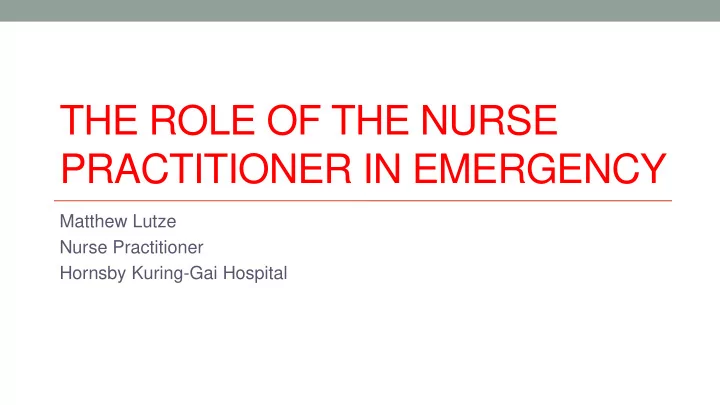

THE ROLE OF THE NURSE PRACTITIONER IN EMERGENCY Matthew Lutze Nurse Practitioner Hornsby Kuring-Gai Hospital
Lets get controvertial... • Anyone here not believe in Evidenced based medicine? • Name of 1 RCT that supports the implementation of the following roles... • Clinical Nurse Consultant • Nursing Unit Manager • Emergency Physician • Emergency Nurse Practitioner • How widely accepted are these roles in our current EDs?
What does the literature say… • Run a medline search for • Emergency Physician • 0 RCTs, 1 Controlled trial (triage based EP) • Clinical nurse consultant • 0 RCTs, 1 Systematic RV • Nursing Unit Manager • 0 RCTs, 4 meta-analyses
* RCTs, Prospective Observational Emergency Nurse Practitioners • How many International trials have been conducted on the role of the ED Nurse Practitioner? • Answer: 12 (high quality studies*) • How many are Australian/NZ ? • Answer: 7/12 (58%) • 2 Systematic Reviews • Commissioned Literature RV (Masso and Thompson) • Since 2015, 10 more Australian ED NP studies… • 2 RCTs
Working with Nurse Practitioners • When were nurse practitioners first introduced into in Australia? • 1 st Authorised NPs Dec. 2000 – Sue Denison and Jane O’Connell • 1 st Positions May 2001 – Sue Denison and Ollwyn Johnson • In 1994-2000 pilot projects evaluated NP models: • Rural and Remote areas • Midwifery • Well women's screening • Emergency services • Urban homeless men service, and • general medical practice • Evaluation found that these nurse practitioners were "feasible, safe, effective in their roles and provide quality health services."
How has the role evolved in ED? • Nurse Practitioners - addressing the unmet needs of patients • Short version… • Most = Fast Track • Why? Triage... • Focus of the role was on see and treat • However, not completely true... • Plenty practicing outside of Fast Track (& not all Fast Tracks are the same)
ED Nurse Practitioners • ENPs are increasingly used to meet the needs of complex problems
What’s the challenge for ENPs • Premise: Unacceptable to receive different care based on geography • Rural/Metro differences in ENP roles • In Regional/Rural Areas = ENPs ↑ Critical Care • Metro Areas = ENPs ↑ Fast Track • Unlike ACEM Trainees; no national developed curriculum for ENPs • Left to the Individual/Facility/Department • ✔ Meets the needs of that location • ✖ Lacks Transferability • Inconsistencies about the specific training of ENPs • Role confusion
Endorsement is hard… • Prerequisites: • RN with 3-5 years of experience • Masters Degree – Specific to Nurse Practitioners • Diagnostics, Prescribing, Hx and Physical Examination, Complex Case Rx • VIVA in front of panel • Then 5000 hours (3 years 1.0 FTE) of ‘advanced practice’ • Transitional or Candidate period (mentored – ENP or EP) • Portfolio submitted to AHPRA – typically takes 6 months to prepare • Typically takes 5 years from enrolment to endorsement
There are Practice Standards for ENPs • Published in 2015 • 3 modes of Practice • Rapid • Focused • Disposition • 3-5 Categories in each standard • Not formally credentialed • Implied within AHPRA standards for NPs http://www.azille.com.au/standards.pdf
Credentialing … • Finding the balance • More Training vs. Variation • Politics… • Nursing vs. Medical Organisations • Sharing Education & Training • Power and Governance • Public Expectations • Individual ENPs • Content vs. Driven
Interprofessional Practice…
UK – Moved towards this approach http://www.rcem.ac.uk/docs/Training/4.1%20ACP%20Curriculum_FINAL.pdf
USA - Doctoral Nurse Practitioner Training • USA • ACEP have position paper on training • Move towards Doctoral prepared NPs (2015 recommendation) • Being considered in Australia • Benefits • Great rigor for NP roles • Limitations • Still lack specific training in EM
ACEM…CENA… ACNP… • Is it time to consider interprofessional training of ED Nurse Practitioners within Australia?
Open to discussion… Thanks!
Recommend
More recommend